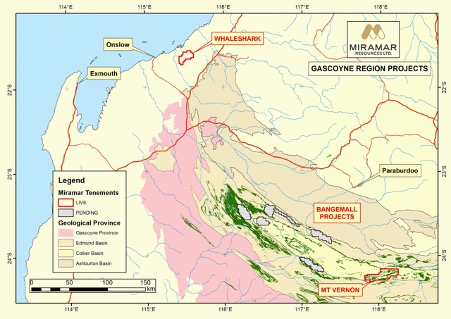Miramar Resources Limited (ASX:M2R) has outlined large copper and multi- element anomalies suggestive of buried iron oxide copper gold (IOCG) mineralisation with aircore drilling at the Whaleshark Cu-Au Project in Western Australia.
The Whaleshark Project is located approximately 40km east of Onslow, in the Ashburton region of WA, and is characterised by a large folded Proterozoic Banded Iron Formation and granite complex under approximately 100m of later Carnarvon Basin sediments.
Miramar’s Executive Chairman, Allan Kelly, said the aircore drilling results had been successful in mapping the geology of the basement rocks, as well as confirming the potential for Whaleshark to host significant IOCG mineralisation.
“The first pass aircore drilling at Whaleshark has successfully outlined large multi-element anomalies in several elements generally associated with IOCG mineralisation,” Mr Kelly said.
“The scale, magnitude and suite of elements seen at Whaleshark is very similar to the large Ernest Henry IOCG deposit in Queensland, which is our target at Whaleshark.
“We are therefore eager to get back to Whaleshark next year and refine targets for deeper RC and/or diamond drilling,” he said.
Aircore drilling
Aircore drilling was completed during August and September testing beneath MMI soil anomalism identified during 2021.
Holes were drilled on a 250m x 250m grid and targeted the unconformity between the Cretaceous Carnarvon Basin sediments and the underlying Proterozoic basement.
A total of 60 holes were completed, mostly across the main MMI anomaly (Target A) however the programme was shortened due to slow penetration rates and the discovery of potential heritage sites at the southern edge of the survey area. Target B therefore remains untested by drilling at this stage.
Hole depths ranged from 25 to 147 metres with basement intersected at depths from 20m to 126m. A total of 8 holes did not reach basement, including seven within Target A.
The drilling intersected silcrete and/or limestone, unconsolidated black mudstone and basal gravels, which commonly contain sulphides, before intersecting Proterozoic basement rocks including biotite granodiorite, biotite schist and occasional mafic rocks,
Sulphides, predominantly pyrite, were observed in the basement rocks in several holes.
In each hole, samples were taken from 4m above the unconformity to the end of hole and were assayed for a multi-element suite including copper and IOCG pathfinders such as gold, silver, uranium, molybdenum and rare earth elements (REE’s).
Future work
Given the results of the recent drilling, the company plans to conduct further work at Whaleshark in 2023, with the aim of refining targets for deeper bedrock RC and/or diamond drilling, including the following:
• completion of a comprehensive heritage survey
• moving loop EM surveys over the MMI anomalies
• further aircore drilling, including at Target B for the first time.
For further information please visit: https://www.miramarresources.com.au/












